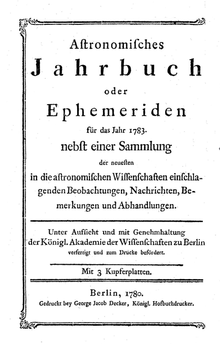Ephemeris
![]()
This article is about the astronomical subject of ephemerides. For the ancient documents of the same name, see Ephemerides of Alexander the Great.
The ephemerides (from the ancient Greek ἐφήμερος ephḗmeros "for a day", from ἐπί epi "on" and ἡμέρα hēméra "day") are the position values of moving astronomical objects related to a respective convenient astronomical coordinate system. Their name expresses that such position values are usually given for one day at a time. They are calculated from the orbital elements and published in the form of tables with daily position values of sun, moon, planets and comets.
Ephemerides are used not only in astronomy but also in celestial mechanics, astrogeodesy, astronautics and astrology. They were also used until the second half of the twentieth century in maritime and aviation as an aid to navigation.

For ephemerides published in 1783 (Berlin, 1780)
Applications
In printed form, ephemerides are available as astronomical yearbooks or, for seafaring, as nautical yearbooks. Among the earliest astronomical prints are the Ephemerides astronomicae of Regiomontanus, published in 1474, which Christopher Columbus used for navigation on his voyages of discovery.
Ephemerides for observational astronomy either use the full circle of 360 degrees along the ecliptic or give the position in equatorial coordinates. The calculation of ephemerides is one of the achievements of astronomical phenomenology and is now part of many astronomical computer programs or interactively available on the Internet.
For a satellite, the ephemeris data describes the apparent orbit in mathematical form. In the Global Positioning System (GPS) and other GNSS systems, this orbit data is part of the signal emitted by each satellite, which is then the basis for calculating the receiver position.
To estimate the probability of a possible collision of two bodies in the solar system, it is necessary to know the positions of the bodies and the temporal evolution of their orbital elements precisely. Therefore, ephemeris catalogues for asteroids are created in order to be able to determine their orbital data more precisely, which are usually only inadequately known. Special attention is paid to Earth orbital crossers, whose impacts on Earth could become a threat.
Astrological ephemerides give the ecliptical longitude of the celestial positions as degrees of the zodiacal signs. The indication of the ecliptic latitude is not common in all astrological ephemerides.
The calculation of the aspects of actual sunrise and sunset and the day arc of the sun is of particular importance for the calculation of the effectiveness of solar systems as well as in architecture for an estimation of the incidence of the sun; this is usually implemented in CAD software as a light module. Also of interest for landscape photography is the time and position of sunrise and sunset at a chosen location.
Ephemeris Calculator
The ephemeris calculation as a field of activity of astronomical phenomenology is carried out on the basis of the actually observed positions of the celestial bodies and the theory of gravitation. For future values, the expected orbital perturbations are taken into account. For this purpose, computational models such as planetary theory are set up to make the perturbation theory more precise.
Important historical tables for the ephemeris calculation were the Alfonsine tables about 1252, the Prutenian tables 1551 and the Rudolfinian tables 1627.
Search within the encyclopedia